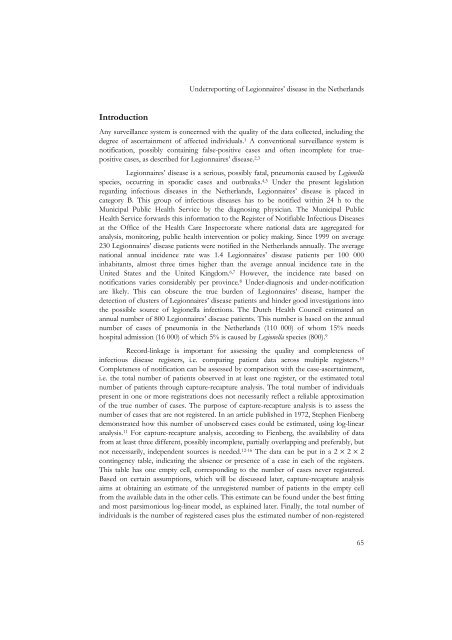Rob van Hest Capture-recapture Methods in Surveillance - RePub ...
Rob van Hest Capture-recapture Methods in Surveillance - RePub ...
Rob van Hest Capture-recapture Methods in Surveillance - RePub ...
You also want an ePaper? Increase the reach of your titles
YUMPU automatically turns print PDFs into web optimized ePapers that Google loves.
Introduction<br />
Underreport<strong>in</strong>g of Legionnaires’ disease <strong>in</strong> the Netherlands<br />
Any surveillance system is concerned with the quality of the data collected, <strong>in</strong>clud<strong>in</strong>g the<br />
degree of ascerta<strong>in</strong>ment of affected <strong>in</strong>dividuals. 1 A conventional surveillance system is<br />
notification, possibly conta<strong>in</strong><strong>in</strong>g false-positive cases and often <strong>in</strong>complete for truepositive<br />
cases, as described for Legionnaires’ disease. 2,3<br />
Legionnaires’ disease is a serious, possibly fatal, pneumonia caused by Legionella<br />
species, occurr<strong>in</strong>g <strong>in</strong> sporadic cases and outbreaks. 4,5 Under the present legislation<br />
regard<strong>in</strong>g <strong>in</strong>fectious diseases <strong>in</strong> the Netherlands, Legionnaires’ disease is placed <strong>in</strong><br />
category B. This group of <strong>in</strong>fectious diseases has to be notified with<strong>in</strong> 24 h to the<br />
Municipal Public Health Service by the diagnos<strong>in</strong>g physician. The Municipal Public<br />
Health Service forwards this <strong>in</strong>formation to the Register of Notifiable Infectious Diseases<br />
at the Office of the Health Care Inspectorate where national data are aggregated for<br />
analysis, monitor<strong>in</strong>g, public health <strong>in</strong>tervention or policy mak<strong>in</strong>g. S<strong>in</strong>ce 1999 on average<br />
230 Legionnaires’ disease patients were notified <strong>in</strong> the Netherlands annually. The average<br />
national annual <strong>in</strong>cidence rate was 1.4 Legionnaires’ disease patients per 100 000<br />
<strong>in</strong>habitants, almost three times higher than the average annual <strong>in</strong>cidence rate <strong>in</strong> the<br />
United States and the United K<strong>in</strong>gdom. 6,7 However, the <strong>in</strong>cidence rate based on<br />
notifications varies considerably per prov<strong>in</strong>ce. 8 Under-diagnosis and under-notification<br />
are likely. This can obscure the true burden of Legionnaires’ disease, hamper the<br />
detection of clusters of Legionnaires’ disease patients and h<strong>in</strong>der good <strong>in</strong>vestigations <strong>in</strong>to<br />
the possible source of legionella <strong>in</strong>fections. The Dutch Health Council estimated an<br />
annual number of 800 Legionnaires’ disease patients. This number is based on the annual<br />
number of cases of pneumonia <strong>in</strong> the Netherlands (110 000) of whom 15% needs<br />
hospital admission (16 000) of which 5% is caused by Legionella species (800). 9<br />
Record-l<strong>in</strong>kage is important for assess<strong>in</strong>g the quality and completeness of<br />
<strong>in</strong>fectious disease registers, i.e. compar<strong>in</strong>g patient data across multiple registers. 10<br />
Completeness of notification can be assessed by comparison with the case-ascerta<strong>in</strong>ment,<br />
i.e. the total number of patients observed <strong>in</strong> at least one register, or the estimated total<br />
number of patients through capture-<strong>recapture</strong> analysis. The total number of <strong>in</strong>dividuals<br />
present <strong>in</strong> one or more registrations does not necessarily reflect a reliable approximation<br />
of the true number of cases. The purpose of capture-<strong>recapture</strong> analysis is to assess the<br />
number of cases that are not registered. In an article published <strong>in</strong> 1972, Stephen Fienberg<br />
demonstrated how this number of unobserved cases could be estimated, us<strong>in</strong>g log-l<strong>in</strong>ear<br />
analysis. 11 For capture-<strong>recapture</strong> analysis, accord<strong>in</strong>g to Fienberg, the availability of data<br />
from at least three different, possibly <strong>in</strong>complete, partially overlapp<strong>in</strong>g and preferably, but<br />
not necessarily, <strong>in</strong>dependent sources is needed. 12-16 The data can be put <strong>in</strong> a 2 × 2 × 2<br />
cont<strong>in</strong>gency table, <strong>in</strong>dicat<strong>in</strong>g the absence or presence of a case <strong>in</strong> each of the registers.<br />
This table has one empty cell, correspond<strong>in</strong>g to the number of cases never registered.<br />
Based on certa<strong>in</strong> assumptions, which will be discussed later, capture-<strong>recapture</strong> analysis<br />
aims at obta<strong>in</strong><strong>in</strong>g an estimate of the unregistered number of patients <strong>in</strong> the empty cell<br />
from the available data <strong>in</strong> the other cells. This estimate can be found under the best fitt<strong>in</strong>g<br />
and most parsimonious log-l<strong>in</strong>ear model, as expla<strong>in</strong>ed later. F<strong>in</strong>ally, the total number of<br />
<strong>in</strong>dividuals is the number of registered cases plus the estimated number of non-registered<br />
65

















